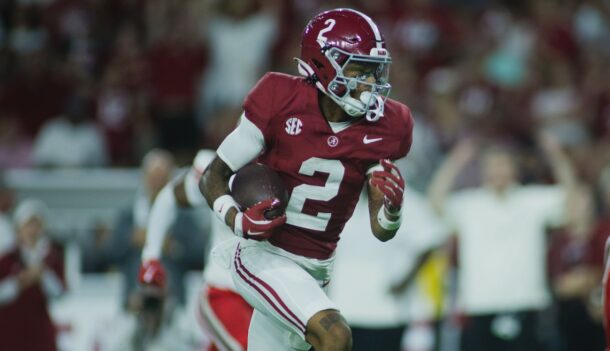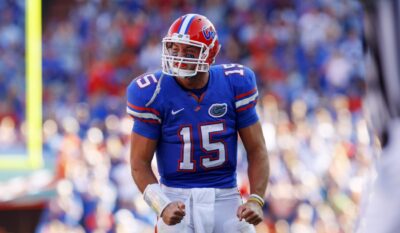
March sadness: 3 thoughts on Florida’s bubble bursting loss to Texas A&M in SEC Tournament
Playing only 2 hours from their campus in Gainesville, Florida showed up 12 minutes late for the SEC Tournament in Tampa on Thursday afternoon. The Gators trailed Texas A&M 26-11 at the under-8-minute media timeout, and despite cutting it to 8 at the half, the Gators looked left for dead in the second half, trailing by 16 points with just 10 minutes to play.
Instead of picking up their ball and going home, Florida staged a furious rally, outscoring the Aggies 32-16 down the stretch to force overtime.
The game remained tight in the extra frame, only to see the Gators victimized by a horrific no-call turned foul-call after an officials conference orchestrated by referee Pat Adams. That decision allowed Texas A&M, which had appeared to turn the ball over on an inbounds play, to shoot free throws and tie the game at 80, rather than Florida getting the ball late up 2 points with A&M forced to foul. To their credit, the Aggies took advantage of the break referee Adams gave them. And after Florida missed a potential go-ahead 3, Hassan Diarra, a 27% 3-point shooter on the season, buried a 3 with a defender in his face to give Texas A&M the win.
Here are thoughts on Florida’s bubble-bursting loss.
Outside of Niels Lane and Kowacie Reeves, no Gator matched Texas A&M’s team energy and effort
Say what you will about the talent on Buzz Williams’ 3rd Texas A&M team, they definitely fight and play hard. The Aggies entered the SEC Tournament ranking 3rd nationally in steal percentage, per KenPom, a testament to their active hands and effort on defense. They smothered the Gators with that energy from the tip on Thursday, leading from wire to wire.
Florida’s biggest issue in the first half?
A swinging gate of a defense that allowed Texas A&M to get whatever it wanted in the paint, as Florida struggled to defend straight-line drives. When Florida did help, they left Texas A&M shooters wide open, and the Aggies didn’t waste the opportunities. Texas A&M shot 58.3% from the field and 55.6% from 3 in building an 8-point lead at the break.
Even after the break, Florida was out-hustled and fought by the Aggies. A&M extended the lead to 13 in 3 minutes to start the second half, forcing 4 Florida second-half turnovers before the first media timeout.
It was a shocking display of lack of fire and focus from a Florida team that entered the game on the wrong side of the bubble, listed in the First Four Out at Bracket Matrix, which aggregates all bracketology sites, before the tip. Florida should have played like a desperate team, one that knew it needed at least one win, and probably two, to advance to the NCAA Tournament. Instead, Florida played with such little fight that the Aggies were able to score easy, loud baskets, including Quentin Jackson’s off-the-backboard passes for dunks early in the second half.
Florida did receive terrific energy from substitutes Niels Lane and Kowacie Reeves, two of Florida’s only roster pieces with NBA size and length, and essentially the only Gators unbothered by Texas A&M’s active hands and physicality. Lane was marvelous with lockdown defense, a career-high 16 points, a career-high 9 rebounds, a block and 2 steals.
Reeves, a freshman, was also magnificent, posting 21 points, 6 rebounds and a steal, and hitting a pair of monster 3s (actually, one was a 4-point play) that helped Florida tie the game at 70 late in regulation.
But no one else on the Gators matched Texas A&M’s energy all afternoon until it was far too late.
That begs the question, posed by Florida writer Eric Fawcett before the game: Why didn’t Lane, an instant energy guy who metrics say is one of the best defensive players in the country, start? Why not start a senior like defensive stopper Brandon McKissic, as opposed to a weak defender like Myreon Jones? Florida’s first-half lineup has been outplayed and scored all season:
Florida starting the SEC Tournament with:
Appleby
Jones
Fleming
Duruji
CastletonThis lineup was outstanding against lower competition in non-conference play (a ridiculous +41 net rating) but has struggled in SEC play with a -24 net rating. We’ll see how the move pays off.
— Eric Fawcett (@EricFawcett_) March 10, 2022
The lineup Florida lined up in the second half? A dominant group — and the one that should have started the game:
Florida’s second half starting lineup of:
Appleby
Jones
Lane
Fleming
CastletonHas performed much better than the group that started the first half. This lineup has a +18 net rating in SEC play.
— Eric Fawcett (@EricFawcett_) March 10, 2022
The Gators didn’t respond well to Texas A&M’s traps and double teams in the post
Florida had limited turnovers down the stretch this season, posting 10 turnovers or more only twice in their final 7 games. They were miserable in that category Thursday, posting 18 turnovers off 14 Aggies steals. That helped Texas A&M post double-digit fastbreak and transition points, meaning even when the Aggies didn’t get what they wanted in the frontcourt, they found easy ways to score off Florida mistakes.
The biggest mistake-makers? Florida stars Colin Castleton and Tyree Appleby.
Castleton had responded quite well to double teams in February, picking up 3 or more assists or more in multiple games, mostly on passes to open shooters out of double teams. Castleton was slow to react to double teams Thursday, and despite 3 assists, the senior coughed up 2 turnovers in the post. Even when Castleton did find shooters, the Gators were hesitant or couldn’t make the shots, shooting an abysmal 5-for-24 from deep on the afternoon.
For Florida to win, the Gators needed the All-SEC version of Castleton on both sides of the basket. The Gators were 5-1 this year in SEC play when Castleton had 3 blocks or more entering the game, but 0-6 in games Castleton played where he didn’t record a block. Florida received none from the big man Thursday afternoon. Castleton also never found a rhythm offensively, scoring just 13 points and missing a key free throw late as the Gators tried to rally.
Appleby struggled for the second consecutive game. After a 6-point, 0-assist effort against Kentucky, the senior point guard was held to 0 points on 0-4 shooting with 3 turnovers Thursday. He was relegated to the bench for the majority of the second half and overtime.
Florida’s best wins of the season came when both Castleton and Appleby produced at a high level. Neither did that Thursday.
Florida has existential questions to ask about its program after a disappointing 19-13 season that will end in the NIT
Florida’s entered the SEC Tournament with the conference’s longest streak of NCAA Tournament appearances, but the loss all but formalizes the end of that impressive run. The Gators have several seniors, and as a result, are likely to accept an NIT bid if invited, but players don’t go to Florida to play in the NIT.
Mike White has done an admirable job replacing a generational, Hall-of-Fame coach in Billy Donovan with integrity, running a clean program and posting 7 winning seasons. White has also won at least 1 NCAA Tournament game in all 4 of his NCAA Tournament appearances, and advanced to an Elite Eight.
But the Gators have been a bubble team in 3 of White’s 7 years, ending on the wrong side of the bubble twice. Florida hasn’t truly competed for an SEC championship since his third season, when the Gators finished 3rd in the league and led the SEC and the country in Quad 1 wins.
That means the program with the 2nd-most SEC titles over the past 30 years hasn’t competed to win 1 in the past 4 seasons. Florida simply has too much tradition, too much administrative support and too good a natural recruiting base to not compete for SEC championships. Scott Stricklin doesn’t have a hoops background, but he can see the banners in Exactech Arena, as well as the increasing number of empty seats at home games. Apathy is a dangerous thing, and Florida must play better on the court in 2022-23.
White has an $8.75 million buyout, which may be prohibitive, especially given what Florida just agreed to pay Dan Mullen to have him not coach the remainder of his sizeable football coaching deal. White is also highly respected, both by the administration and by those who make the big decisions inside the athletic department.
White also earned an immense amount of goodwill for the way he handled a terribly difficult situation a season ago, when All-American Keyontae Johnson collapsed on the court at Florida State. The Gators took 2 weeks off from basketball while White slept on hospital couches, came back together, and made the NCAA Tournament anyway, coming a media timeout short of the Sweet 16 despite the loss of the preseason SEC Player of the Year. All of these factors make moving on from White by firing him unlikely.
There are whispers, however, that White may be looking to make a graceful exit. Shaka Smart did this at Texas last offseason, jumping on a less high-profile, but still high-quality job, at Marquette. White may find a similar move, to say, a respected Big East program like Butler, equally appealing. Should the job open at his alma mater Ole Miss, perhaps there would be mutual interest.
As for Florida, they may view a departure by White as an opportunity for both sides to gain a fresh start. Should White show interest elsewhere, it’s distinctly possible the Gators may be willing to let him walk away.
In any event, Florida basketball needs an identity, whether White continues or doesn’t.
White’s teams play hard, and the culture in the basketball building is strong. But Florida isn’t great offensively and they are no longer an elite program defensively. They recruit well, but without any particular playing style or vision of who you want to be as a program, it is far more challenging to construct a roster.
These are questions Florida needs to address, and after the program’s first NIT season since White’s first year, they’d better do it sooner rather than later.
Neil Blackmon covers Florida football and the SEC for SaturdayDownSouth.com. An attorney, he is also a member of the Football and Basketball Writers Associations of America. He also coaches basketball.







